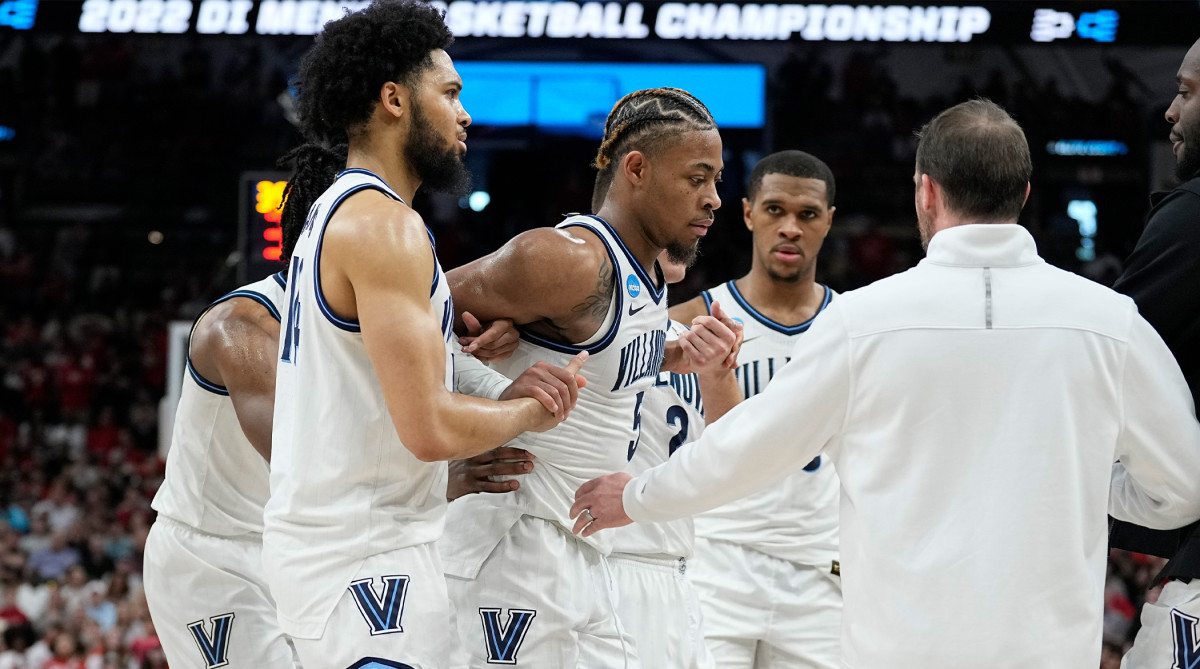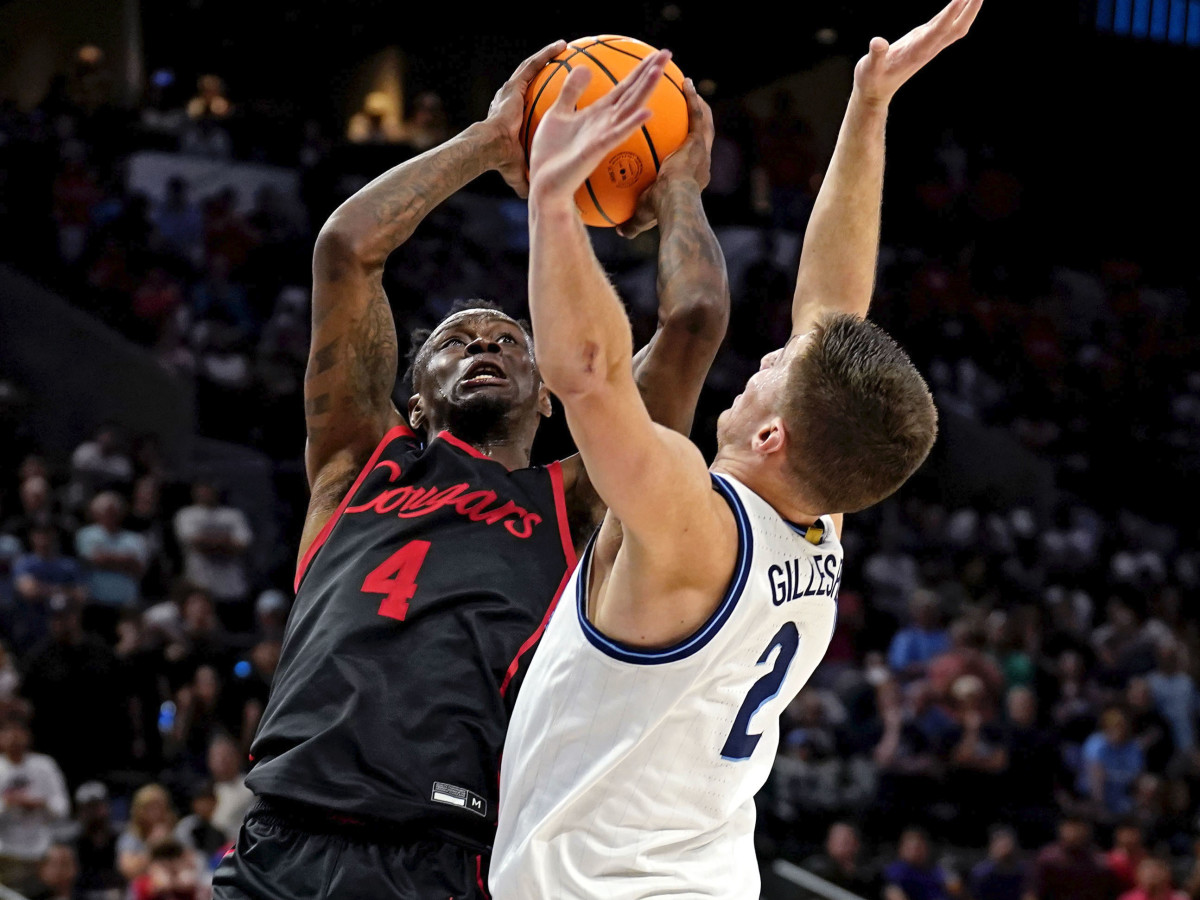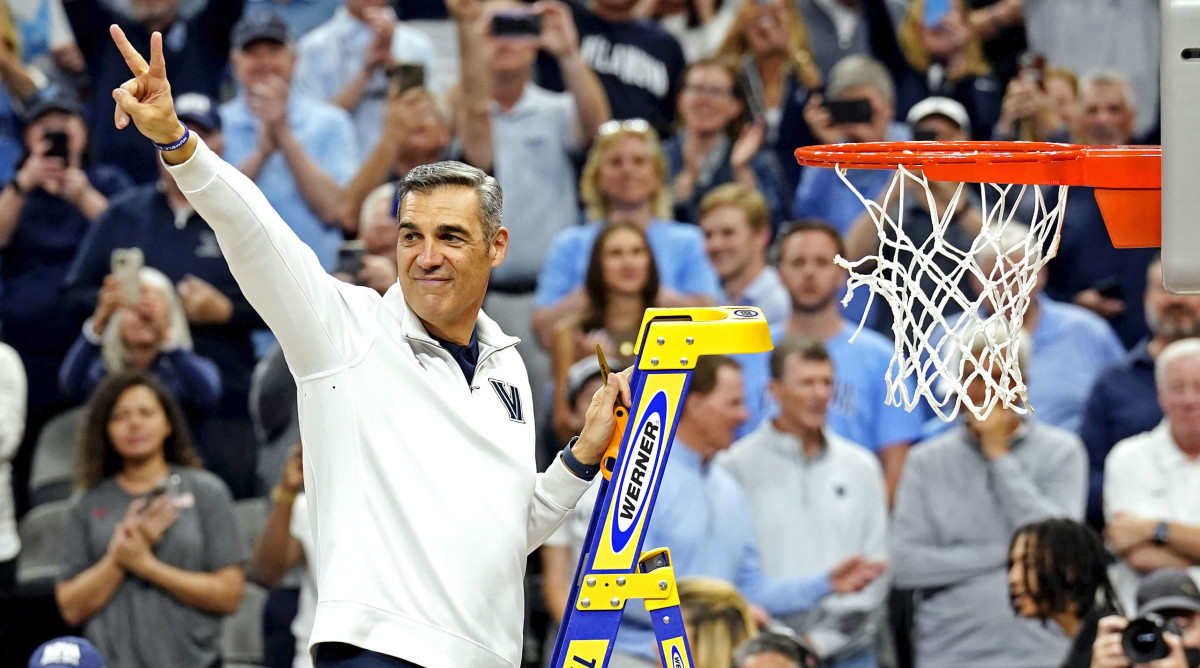Vintage Villanova? Maybe Not. Does It Matter?
SAN ANTONIO – Villanova guard Collin Gillespie grabbed the final rebound and sprinted across the court at the AT&T Center. He threw the ball toward the ceiling and unleashed a medieval scream. Anyone who caught that moment, brief as it was, would never have believed that Villanova and its Super Senior guard had just won a game so ugly, and so bruising, that it left a mark—several, really—that could be felt next week in New Orleans.
The contrast was evident immediately, the gulf between what Villanova had accomplished and how much it had cost them made painfully clear. While fans waved signs that read WE BELIEVE and the Wildcats’ mascot hopped on the back of a male cheerleader, the ladder taken out for net cutting remained empty, as did the makeshift stage set up for the celebration.
Instead, Gillespie beelined for a teammate. Most Wildcats gathered in a corner near their cheering section. They were surrounded by photographers, security guards and team officials, everyone huddled around guard Justin Moore, who had fallen late in the second half and was unable to rise without assistance. Armchair doctors across the country wondered if Moore had torn his right Achilles tendon, lowering the championship hopes of a team with shallow depth and an already hobbled captain in Gillespie.

Villanova (30–7) players wore championship hats as they checked on their fallen comrade, the juxtaposition striking, still. On any other night, with any other ending, the celebration would have been not just heightened but justified. This is a program that’s 20–3 in its last six NCAA tournaments, the mere three losses in five previous NCAAs owing to a pair of national titles, won in 2016 and ’18. This is a team that doesn’t feature an NBA lottery pick, that wasn’t a powerhouse all season (like Arizona, the region’s top seed) and wasn’t a trendy analytics darling (like Houston, the fifth seed and the Wildcats’ opponent Saturday night). While pundits questioned Villanova’s depth and the talent in its rotation, the Wildcats did what they have done all season. They won, moved forward and proved a lot of people wrong.
An obvious question lingered afterward: at what cost?
Jay Wright understandably wanted to save next week for, well, next week. He spoke, instead, of the pride that bubbled as he watched his team—playing a “true road game,” discounted, the Cougars’ late run, the Wildcats’ composure, the big shots. To Wright, Saturday spoke to a veteran roster, guys “who have been in the moment before.” No, he would not apologize for making another Final Four. He didn’t have to. “It feels great, man,” he said. “Never gets old. It’s the ultimate.”
Reality hit quickly, in the form of a question. How was Moore? An x-ray revealed no broken bones, Wright said, adding that an MRI will be performed when the team arrives back in Pennsylvania. “Probably not good,” Wright said, smile fading.
Before the injury, before tip-off even, Villanova jogged on court under the strangest circumstances. The Wildcats were the higher seed (No. 2), the more experienced team and the program with two national titles in the last six seasons. They were also underdogs against a lower seed with younger players, and, after watching Houston dismantle Arizona late Thursday, it wasn’t that difficult to see why
Houston had athletes, a veteran coach in Kelvin Sampson, played suffocating defense and displayed efficiency on both ends of the floor—the exact kind of makeup that portends a championship season. Despite losing three starters from last year’s Final Four team, then losing both its top scorer (Marcus Sasser) and its most talented Cougar (Tramon Mark) before Christmas, this Houston team wowed. When the Cougars knocked out Arizona on the same night Gonzaga lost, they became KenPom’s highest rated team left in the tournament. They said they didn’t pay attention to such rankings, but how, then, did they know about them?
Perhaps the expanding bandwagon had a point. But Villanova seemed to present its own matchup problems, and those were being overlooked. The Wildcats were balanced, if not deep; they also led the country in free-throw percentage, their 82.6 percent on pace to set a Division I men’s record, and Houston fouled a lot. Villanova didn’t mind the tortoise pace the Cougars force opponents into; the Wildcats preferred slow, steady and stealth. Maybe Villanova could out-Houston the Cougars. Maybe.
A version of a home-state crowd filed into the arena to find out. During warmups, a group of Houston players gathered near the sideline to goof off and block each other’s shots. They laughed whenever someone swatted one. They certainly seemed loose, and they knew the crowd would roar behind them.
The Cougars won the tip, and, right away, a contest that lacked artistry—for anyone who’s not really into bruises—began the only way it could have: with a thud. The game came with its own soundtrack: the thwack of bodies colliding, the crash of players spilling to the hardwood like a pileup on the interstate, the grunts of large athletes trying to move other larger athletes and more than a few short cries in pain. Anyone who closed their eyes and just listened might have wondered if they had been transported from an arena to a horror movie.

Villanova opened a 5–0 advantage, and while that normally wouldn’t qualify as significant, on this night, in this game, it most definitely was. When forward Jermaine Samuels spun inside for an easy lay-in, the Wildcats led, 9–2. They didn’t know it then, but they had all the margin they would need, not even five minutes in.
Still, it seemed fair to wonder if Villanova had squandered a chance at a larger lead. Houston continued to clamp down on Gillespie, forcing the Wildcats to find points elsewhere. But while the Cougars clanged three-point attempts off the rim and turned the ball over, the margin remained steady, leaving an opening for Houston to slide back in. At one point midway through the first half, Samuels caught the ball inside and braced himself. He knew what was coming–an opponent landing on his back, along with the inevitable bruise.
Despite the attention Houston paid Gillespie, his team plodded forward, same as always, just as Villanova had done in tournament victories over Delaware (No. 15 seed), Ohio State (7) and Michigan (11). Doubters fairly pointed out that the Wildcats had last faced a top-20 KenPom opponent way back in December, and that opponent, Baylor, routed them by 21 points. But perhaps those predicting the demise of Villanova looked too closely at what the Wildcats could not do or had not done–and not closely enough at what they could do and had accomplished. “Villanova is one of those iconic names in college basketball,” Houston coach Kelvin Sampson said. Meaning: doubt them at your own risk.
Take Samuels, for instance. He poured in 22 points against the Wolverines, spinning through traffic like a loose T-shirt inside a washing machine, finding angles for lay-ins and baby hooks. When the Cougars chose to focus their attention on Gillespie, it was Samuels who stepped in to fill the scoring void.
The bricked jump shots … the swarming defenses … the game so ugly that at times the ugliness was beautiful in its mind-numbing consistency … it all added up to a 27–20 lead for Villanova at the half. The first team to 50 would win, or so it seemed. And if neither made it to 50, then they could add up their bruises, scratches and cuts and declare a winner by wounds alone.
Wright didn’t panic at halftime. He didn’t need to. His team was ahead and had quieted the “home” crowd. His players were more experienced. Everything beyond Houston’s smothering defense was just noise anyway, and noise he was familiar with, noise he had long ago surmounted. Before the recent stretch of national title runs, Wright was known as a great coach whose teams regularly lost during the first week or the first game of the second week in the NCAA tournament.
Rather than despair, or make drastic changes, Wright kept doing the same thing. He found tough, disciplined guards to guide his teams in March, then watched as they changed the narrative around his program. “Always the same guy,” said Jalen Brunson, one of those guards, now with the NBA’s Dallas Mavericks. “There’s a way to Villanova basketball, and it starts with him.”

Wright’s steady nature would be necessary earlier this season, when, after the Baylor loss, Villanova stumbled against Creighton later that same week. Again, Wright didn’t panic. He watched his team and saw players who were tired, worn down by a tough non-conference slate. Wright chose to let his leaders, like Samuels and Gillespie, take the lead, and they emphasized daily habits and recovery—then walloped Xavier just before Christmas.
The Wildcats lost only three more games the rest of the season, finished second in the Big East and won the conference tournament, rounding into typical March form. But they would need that same steady guidance here in San Antonio as well. The Cougars clawed their way back in the second half, behind guard Taze Moore, he of the movie script backstory, now recovered from a broken right fibula and tibia that threatened his career and cost him 634 days of basketball.
Perhaps it was simply Houston’s defense that bottled Gillespie. But after playing 23 minutes, his point total matched his foul total—two, for both—meaning either Houston could really defend, or the knee injury Gillespie suffered late against Michigan was bothering him more than he let on. Both are plausible; a combination the most likely.
Every time the Cougars made a run, the Wildcats made a shot to quell momentum. At least, that is, until the end. Houston had one last run left. A defender tied up Samuels on a drive, forcing a jump ball with the possession arrow pointing the Cougars’ way. Moore, who finished with a team-high 15 points, drove inside, drew a foul and made both free throws. For the first time all night, the arena sounded as deafening as it had against Arizona, the crowd so loud the din rumbled. Villanova missed twice more on its next possession, and there came Houston, and there came Moore, slicing through the Wildcats defense for another twisting score. That sequence trimmed the deficit to two points, and the crowd stood and screamed.
Enter Gillespie. Of course. He would say afterward that Houston had been using a “soft blitz” against him. But on this particular possession, for some reason, the defenders switched when he dribbled off a screen from Samuels. Gillespie said he wanted to throw the ball into Samuels in the post. But when the Cougars swapped who they were defending, he noticed a mismatch that resulted. “I wanted to attack it,” he said.
Attack, he did. Dribbling left, crossing the ball over to his right and creating just enough space to uncork a jumper so pure it looked good the moment it left his fingertips. When ball splashed through net, the tenor changed, the run ended and so, effectively, did the game.
Villanova had proven as adept as Houston defensively. The Wildcats held the Cougars to under 30 percent from the field, and Houston made only one of its 20 attempts from three-point range. A team with seven players who average in double figures had only one player surpass 10 points on Saturday. Samuels, as important in protecting the rim as in the game-high 16 points he scored, was named MVP of the South Region. Villanova had indeed out-Houston-ed the Cougars. “Our kids guarded, man; we did guard,” Sampson said. “But their defense was spot on.”
While Sampson described a losing locker room full of the usual tears—“teams that cry, care,” he said—the Wildcats engaged in a celebration that wasn’t all that celebratory. On one hand, there were signs from the cosmos overhead. They had emerged from a talented field in San Antonio, the same city where they won the national title in 2018. They had beaten a top contender from Houston (32–6), the same city where they won the national title in 2016.
“Maybe it’s the barbecue,” Wright quipped. And, while funny, it didn’t change the facts. Gillespie does not appear to be 100-percent healthy. Moore’s season seems over, barring some sort of miracle recovery. This Villanova team wasn’t all that deep to begin with.
Most signs, those ones that Wright and his program never paid all that much attention to, all point to an early exit. And yet, as Samuels snipped a piece of net, and then Gillespie grabbed the scissors, nobody wore any concern they felt inside on their faces. The Wildcats showered their coach with a Gatorade bucket of confetti, the pieces navy and light blue and fluttering toward the stage hastily assembled atop the court. They had improved their title chances just by advancing. But maybe they had damaged their championship hopes at the same time. They’ll find out for sure next week, but Sampson made a fair point about the team that beat his team to move onto the Final Four.
“On a year where I don’t think there’s any great team in college basketball,” he said, “Villanova has as good a chance as anybody.” For now, for the team that college basketball doubted, on Saturday that was enough.
More College Basketball Coverage:
• NCAA Tournament Showcasing Lack of Consistency and Accountability in Officiating
• Inside Tommy Lloyd’s Instant, International Transformation of Arizona
• Collin Gillespie’s Rise to Becoming Villanova’s Soul
• Miami’s Isaiah Wong Focused on Seizing the Moments in March
